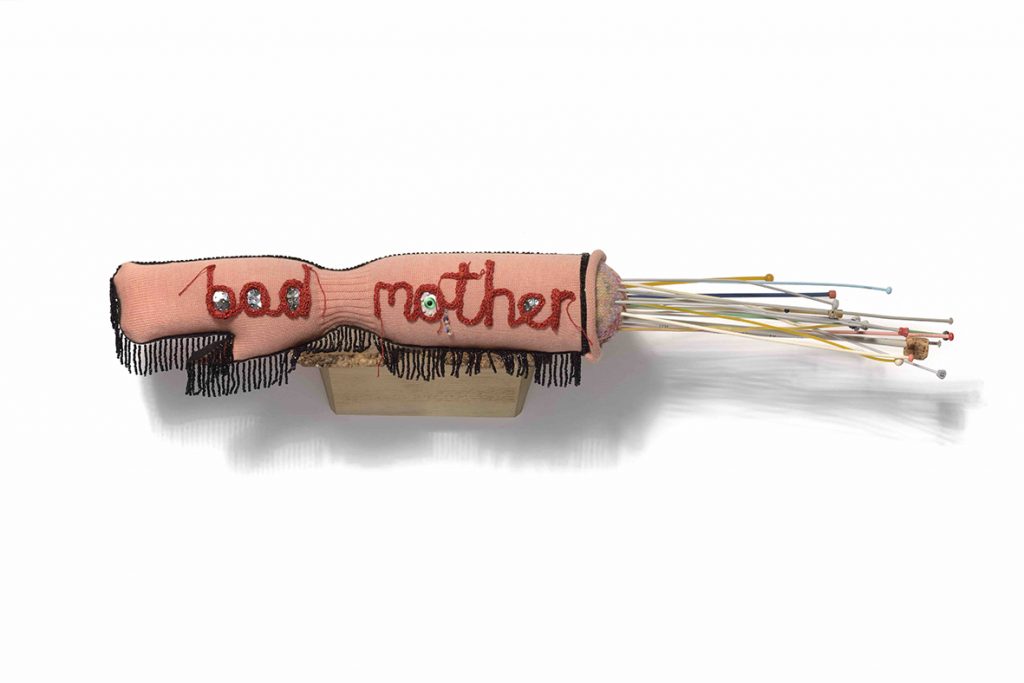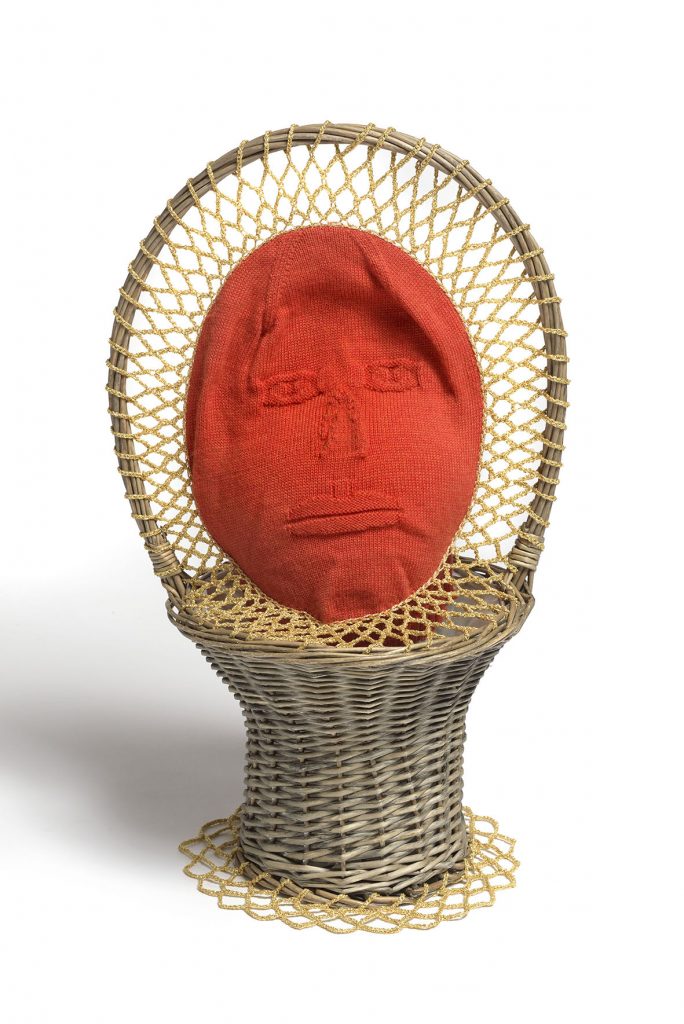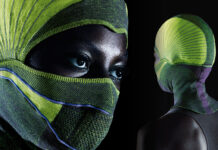In September, we spoke with knitted textiles artist and RCA Textiles tutor, Freddie Robins. Freddie talks about her chosen medium, how she’s uses this to express her thoughts on the human condition and her part in the current Resistant Materials exhibition at M100 in Denmark..
Why knit?
I have knitted since I was a child and was always good at it. It has the right balance of order and freedom for me. I enjoy the technicalities, the maths, and the pushing of boundaries and possibilities within a very structured process. I studied Knitted Textiles at both undergraduate and postgraduate level and have tried to escape its hold over me many times but I always come back to it. Knitting comes with many preconceived expectations, it is ripe for subversion. Knitting is a common art. Everyone has some form of relationship with it. Even if they don’t like it people aren’t repulsed or intimidated by knitting. They come to it with all guards down, expecting it to be gentle, homely and cosy. It is the perfect medium to talk about difficult issues.

Photo credit: Douglas Atfield
You blur the boundaries between art, design and craft. What do you see as the purpose and reasoning behind your practice? Do you have a common thread of inspiration that runs through all of your work?
The purpose of my work is for me to explore issues that I find difficult, or perplexing, through a medium that I like to work in, and am good at. My practice helps me to come to terms with the human condition.
I am interested in blurring boundaries because I hate boundaries, or control of any kind. Boundaries should be questioned and pushed against. They are false constructs and only help maintain hierarchies. Knitting sits low in the hierarchy of creative disciplines, maybe just above crochet and macramé. Whilst this infuriates me it does also give me a rich territory to explore, question and subvert.
The common theme is the human condition. This has seen me explore issues around the body; crime, religion, motherhood and the constant strive for perfection.

Photo credit: Douglas Atfield
What is currently inspiring and driving your practice? Is there anything that is concerning you? What are you finding influential?
I am currently looking at the notion of ‘soft’ and how society views this as a negative attribute. I am interested in the power of soft material. I like the way that with wool and knitting being soft is a positive quality, usually the most highly prized and valuable quality.
Earlier in the year I was in Paris on a personal research trip and saw three very different, but equally inspiring exhibitions, Martin Margiela at Palais Galleria, one of the best exhibitions that I have seen for a very long time, Sheila Hicks at the Pompidou Centre and Black Dolls at La Maison Rouge. Seeing the work of others, and the mental space afforded through the exhibition environment, helps me to structure my own thoughts and resolve ideas.
Can you tell us about the ways in which you collaborate, with other artists, designers and organisations? What is important to you about this?
This season I have collaborated with Donna Wilson on a pair of gloves for her Winter 2018 collection. Donna was one of my students at the Royal College of Art and we have wanted to do something together for a long time but it had to be something that would appeal to her customers. I am also working with Studio Roam, (Lachlan Munro and Sonia Ambrosano), on the production of a huge graphic blanket. Again this has been a long time coming. I enjoy the conversations that you have when you work with others. You do not get this when you are a solitary artist in your studio.

Photo credit: Douglas Atfield
Can you tell us more about the current Resistant Materials exhibition at M100 in Denmark?
Resistant Materials is an exhibition of four UK based artists, Ben Coode-Adams, Fiona Curran, Justin Knopp and me. All four of us work with physical material, employing skill and craft to make our work. We all live outside of London in rural environments and the exhibition explores that life, living outside of the centre and outside of a framework of mutual endeavour.
I have exhibited my series of work entitled, Someone Else’s Dream. The title refers to the idealised view that many people have of living in the countryside. The desire for cheaper and larger housing, a garden, to have more children or a dog, (usually both), better schools, less crime and greater personal safety. A move to the countryside is for many a dream, a dream that, although I do live in the countryside, I do not share. Their dream is my reality.
In this series I have made use of the picture knits that were so popular when I was a teenager, which I have bought on eBay. In the 1980’s these were regarded as highly fashionable but soon fell out of fashion and have never regained serious appreciation. I have been working with picture knits that depict pastoral scenes; farmhouses with animals, villages complete with churches, pretty streams, rolling hills, blue skies and fluffy white clouds. I have not made these jumpers but found them on ebay. Many hours of skilled labour no longer wanted or valued. Using a technique known as swiss darning, an embroidery stitch that mimics the knitted stitch, I have worked on top of the knitted countryside scenes, changing the idyllic picturesque scenes to the scenes of misery that can, and do, happen in the countryside. Some of the scenes that I have embroidered are from personal experience, some from news stories, all have happened in the countryside. I have embroidered a car crash, a figure hanged from a tree, a house fire, a body drowned in a river, fly-tipping and a crime investigation scene complete with white tent, police DO NOT CROSS tape, police van, car and helicopter.
Upon initial viewing these works have a cosy familiarity but the soft, knitted jumpers are completely at odds with the imagery. The material and form resist their stereotype. They exist as a disturbance to those dreams and a friendly reminder of reality.

Photo credit: Douglas Atfield
Where do you source your materials from? Are there any fibres and materials innovations that are exciting you at the moment?
I tend to work with wool because of its availability in great colour ranges. I have shade cards pinned onto my studio wall and drawl over them. I have countless balls of wool that I have just bought for the colour. Wool also has a natural stretch and knits easily, which is what I need when I am making complicated 3-D forms and pushing the limits of the knitted fabric. I also like the cultural associations of wool and it’s strong role in the development of society. Everyone has a relationship with wool, particularly knitting and wool. However, wool does have one drawback – moths. I fantasise about the development of a fibre that has all the properties of wool, is available in a good colour range and in small quantities but is completely mothproof. I see lots of exciting yarns out there but stay away from yarn that will dominate my work. I don’t want the yarn to distract from the form or meaning.
What future plans do you have?
I am interested in doing some more collaborative work with other designers. I am also building up a new body of work in my studio, which I want to exhibit in the near future but I need to find the right forum. Writing too, I have thoughts about writing a book, not a knitting book but a book that in some way relates to the broader issues around knitting. Maybe even a graphic novel. This is a long way off from being realised but it is an idea slowly growing. Things never get resolved quickly for me but that’s fine. It’s not a race.

Subscribe To Our Newsletter
Join our mailing list to receive the latest news and updates from our team.






